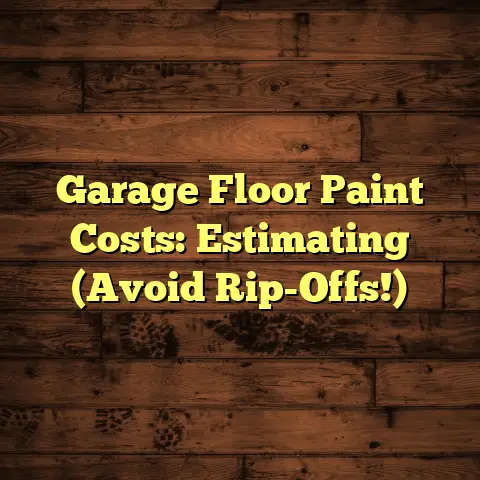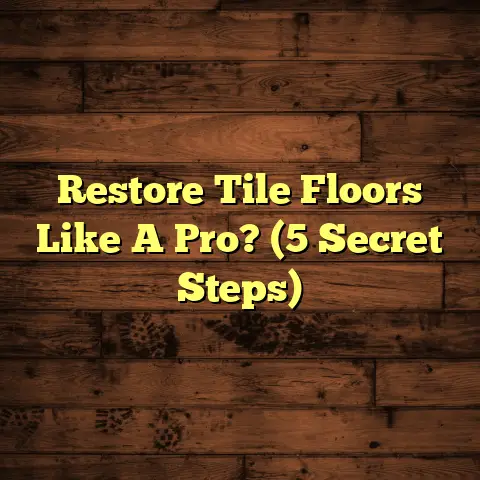Mold Under Floors: Danger Signs? (1 Hidden Risk!)
(1 Hidden Risk!)
And believe me, I’ve seen it all when it comes to floors.
One of the scariest things I encounter?
Mold lurking beneath the surface.
We all want a safe and healthy home, right?
Especially for our families.
Flooring plays a HUGE role in that.
Think about it: it’s what we walk on, what our kids play on, what our pets nap on.
But how often do we really think about what’s under the floor?
That’s where the potential problems hide, and mold is a big one.
It’s a hidden risk that can affect your home’s integrity and your family’s health.
I remember one family, the Johnsons, who called me in because their young daughter had developed a persistent cough.
They’d been to the doctor multiple times, but nothing seemed to help.
Turns out, a slow leak under their kitchen sink had created a breeding ground for mold underneath their vinyl flooring.
It wasn’t visible, but it was definitely there, affecting their air quality and their daughter’s health.
That’s why I’m writing this article: to help you spot the danger signs of mold under your floors before it becomes a major problem.
This is especially crucial if you have children, elderly family members, or anyone with respiratory issues living in your home.
Let’s get started!
Section 1: Understanding Mold
So, what exactly is mold?
In simple terms, it’s a type of fungus that thrives in damp, warm environments with organic materials.
Think of it as nature’s recycler; it breaks down dead stuff.
There are many different types of mold, but some of the most common ones I see indoors are:
-
Stachybotrys chartarum: Often called “black mold,” this one gets a lot of bad press, and rightfully so.
-
Aspergillus: A very common mold, with many different species. Some can cause allergic reactions and respiratory problems.
-
Penicillium: Yep, the same family that gives us penicillin. However, some species can also be allergenic.
Mold needs three key things to survive and thrive:
-
Moisture: This is the big one. Whether it’s a leaky pipe, high humidity, or a flood, mold needs water to grow.
-
Warmth: Mold prefers moderate temperatures, which is why it often thrives indoors.
-
Organic Material: Mold feeds on organic materials like wood, drywall, paper, and even dust.
Think of your subfloor as a giant buffet for mold if moisture is present.
Mold reproduces through tiny spores that are constantly floating around in the air.
According to the EPA, “Mold spores are everywhere.”
They’re microscopic, so you can’t see them, and they’re just waiting for the right conditions to land on a surface and start growing.
That’s why even a small amount of moisture can quickly turn into a mold problem, creating a potential health risk for your family.
Section 2: Common Causes of Mold Growth Under Floors
Okay, so we know what mold is and what it needs to grow.
But how does it end up under our floors?
Here are some of the most common culprits I see:
-
Leaks from Plumbing or Appliances: This is a big one. A slow, undetected leak under your sink, dishwasher, or refrigerator can provide a constant source of moisture.
-
High Humidity Levels in the Home: Especially in basements and bathrooms.
If your home feels damp, or you notice condensation on your windows, you likely have high humidity.
According to the EPA, humidity levels should be kept between 30-50% to prevent mold growth.
-
Poor Ventilation in Crawl Spaces or Basements: Crawl spaces and basements are often damp and poorly ventilated, making them ideal breeding grounds for mold.
-
Flooding or Water Damage from Storms: Even a small amount of floodwater can lead to significant mold growth if not dried properly.
I can recall a time when my neighbor’s basement flooded after heavy rain, and within a week, mold was growing on the drywall and under their carpet.
Different types of flooring can also interact with moisture differently:
-
Carpet: Carpet is like a sponge. It absorbs moisture and provides a perfect environment for mold to grow.
-
Hardwood: Hardwood can warp and buckle when exposed to moisture, creating cracks and crevices where mold can thrive.
-
Laminate: Laminate is generally more water-resistant than hardwood, but if moisture gets underneath it, it can become trapped and lead to mold growth.
-
Vinyl: Vinyl is water resistant, but moisture can still get trapped underneath it around the edges or seams.
The key takeaway here is that any source of moisture, combined with organic materials, can create a perfect storm for mold growth under your floors.
Section 3: Recognizing the Danger Signs of Mold Under Floors
Alright, let’s get to the important part: how to spot the signs of mold under your floors.
Here’s a comprehensive list of things to look (and smell!) for:
-
Unexplained Odors (Musty or Damp Smells): This is often the first sign that something’s not right. If you notice a persistent musty or damp smell in a particular area of your home, especially near the floor, it could be mold.
-
Visible Discoloration or Staining on Floors or Walls: Look for dark spots, water stains, or any other unusual discoloration on your flooring or baseboards.
-
Warping, Buckling, or Lifting of Flooring Materials: If your hardwood floors are warping, your laminate is buckling, or your vinyl is lifting, it could be a sign of moisture and mold underneath.
-
Allergic Reactions or Respiratory Issues Among Family Members: If you or your family members are experiencing unexplained allergy symptoms, such as sneezing, coughing, runny nose, or itchy eyes, it could be due to mold exposure.
Pay attention to whether these symptoms worsen when you’re at home.
Here’s a personal story: I once had a client who thought they were just experiencing seasonal allergies.
But after I pulled up their carpet, we found a significant mold problem underneath.
Once the mold was removed, their allergy symptoms disappeared.
Here are some subtle signs that are easy to miss:
-
Condensation on Windows: Excessive condensation can indicate high humidity levels, which can lead to mold growth.
-
Peeling Paint or Wallpaper: Moisture can cause paint and wallpaper to peel, creating a breeding ground for mold.
-
Efflorescence on Concrete Walls: Efflorescence is a white, powdery substance that can appear on concrete walls.
It’s a sign that moisture is seeping through the concrete, which can lead to mold growth.
Be vigilant and aware of these subtle signs.
Don’t dismiss them as just “allergies” or “old house smells.”
Trust your gut.
If something seems off, it’s worth investigating.
I always tell my clients, “When in doubt, check it out!”
Section 4: The Health Risks of Mold Exposure
Okay, so you suspect you might have mold under your floors.
What’s the big deal?
Well, mold exposure can have some serious health consequences, especially for vulnerable populations.
Children, the elderly, and individuals with preexisting health conditions are particularly susceptible to the effects of mold exposure.
Here are some of the potential health effects:
-
Respiratory Issues: Mold can irritate the respiratory system, leading to coughing, wheezing, shortness of breath, and asthma attacks.
-
Allergies: Mold is a common allergen, and exposure can trigger allergic reactions such as sneezing, runny nose, itchy eyes, and skin rashes.
-
Skin Irritations: Mold can cause skin rashes, hives, and other skin irritations.
-
Long-Term Health Effects: Some studies have suggested that long-term mold exposure may be linked to more serious health problems, such as immune system suppression and neurological problems.
According to the CDC, “In 2004 the Institute of Medicine (IOM) found there was sufficient evidence to link indoor exposure to mold with upper respiratory tract symptoms, cough, and wheeze in otherwise healthy people; with asthma symptoms in people with asthma; and with hypersensitivity pneumonitis in individuals susceptible to that condition.”
It’s important to note that not everyone reacts to mold in the same way.
Some people are more sensitive to mold than others.
However, even if you don’t experience any obvious symptoms, mold exposure can still be harmful, especially over the long term.
I had a client once who dismissed the musty smell in their basement for years, thinking it was just “basement smell.”
But after a few years, they started experiencing chronic fatigue and other health problems.
It turned out that they had a significant mold problem in their basement, and their health issues were likely related to mold exposure.
Don’t take mold lightly.
If you suspect you have a mold problem, it’s important to address it promptly to protect your health and the health of your family.
Section 5: The Importance of Regular Inspections
Alright, so how do you prevent mold from taking over your home?
The key is regular inspections and proactive maintenance.
Think of it like going to the dentist: regular checkups can help catch problems early before they become major issues.
Here are some tips for incorporating home maintenance routines to check for signs of moisture and mold:
-
Inspect Your Home Regularly: Set aside some time each month to walk around your home and look for signs of moisture or mold.
Pay particular attention to areas that are prone to moisture, such as basements, bathrooms, and kitchens.
-
Check Under Sinks and Around Appliances: Look for leaks or signs of water damage under sinks, around dishwashers, refrigerators, and washing machines.
-
Ventilate Your Home Properly: Make sure your home is well-ventilated to prevent moisture buildup.
Use exhaust fans in bathrooms and kitchens, and open windows regularly to allow fresh air to circulate.
-
Control Humidity Levels: Use a dehumidifier to keep humidity levels in your home between 30-50%.
-
Clean Up Spills Promptly: Wipe up any spills immediately to prevent moisture from seeping into flooring and other materials.
Here’s a checklist you can use during your inspections:
-
Basement:
- Check for leaks or water damage.
- Look for signs of mold growth on walls and floors.
- Ensure proper ventilation.
-
Bathrooms:
- Check for leaks around toilets, sinks, and showers.
- Look for signs of mold growth on walls and ceilings.
- Use exhaust fans during and after showers.
-
Kitchen:
- Check for leaks under sinks and around appliances.
- Wipe up spills immediately.
- Ensure proper ventilation.
-
Under Carpets:
- Lift up corners of carpets and look for signs of moisture or mold.
I encourage you to involve your family in these inspections.
Make it a team effort.
Teach your kids what to look for and why it’s important.
The more eyes you have on the lookout, the better.
Remember, prevention is always better (and cheaper!) than cure.
Conclusion
So, there you have it: a comprehensive guide to understanding the dangers of mold under your floors and how to protect your home and family.
I know it can seem overwhelming, but the key takeaway is to be proactive.
Stay informed about the signs of mold growth and take action if you suspect a problem.
Don’t ignore musty smells, water stains, or unexplained health symptoms.
These could be warning signs that something’s not right.
Remember the Johnsons, the family I mentioned at the beginning of this article?
Once they addressed the mold problem under their kitchen floor, their daughter’s cough disappeared, and their home became a healthier place.
A healthy home is essential for the overall well-being of your family.
It’s a place where you can relax, feel safe, and thrive.
By taking steps to prevent mold growth and addressing any problems promptly, you can create a healthier and happier home environment for everyone.
So, go forth and inspect your floors!
Your family will thank you for it.





